I argue about financial milestones and different currencies with my wife all the time.
Big milestones in some currencies mean little in others 🙂
But seeing as we’re headquartered in Denmark, our financial results are in Danish kroner.
And we just hit a milestone. We had a million kroner in monthly recurring revenue.
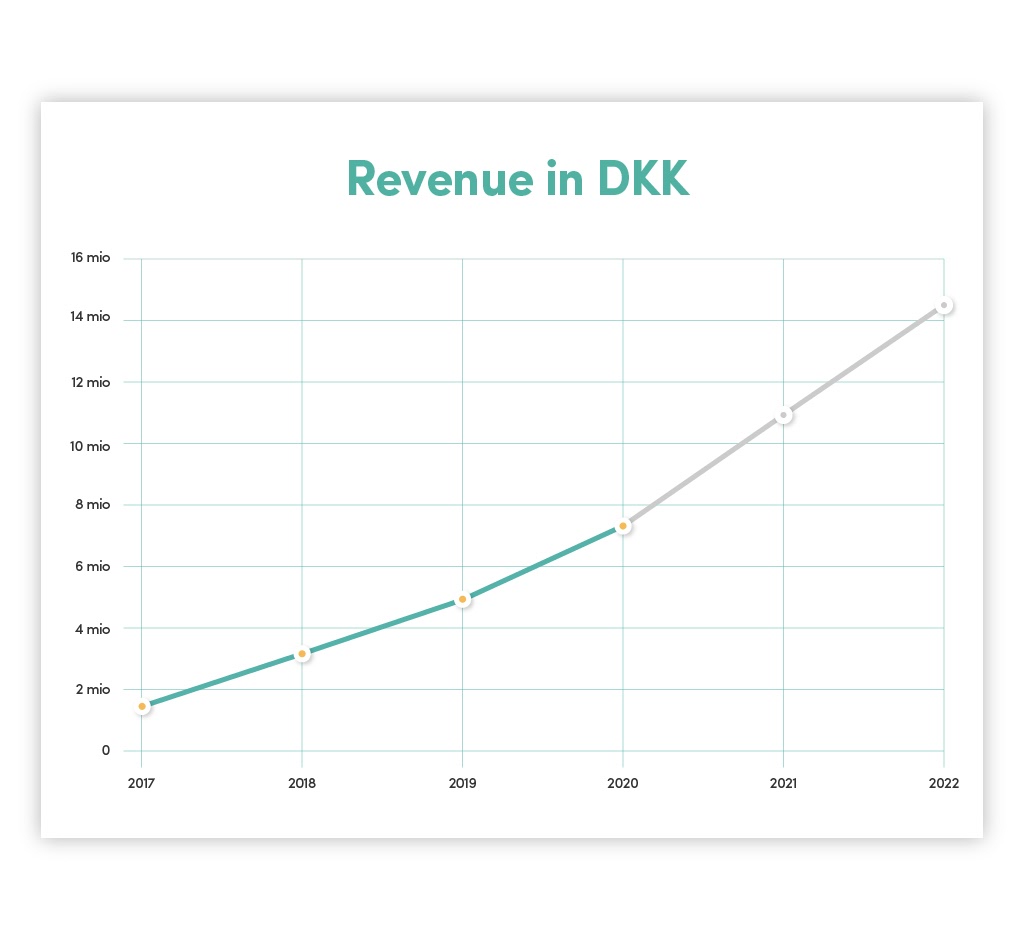
That’s a bit more than $150,000 USD.
WOOHOO!
This is a perfect occasion to deliver another agency update.
Since my last update back in January, we’ve had a host of other new things happen:
- We are getting our own office space
- Employer branding has become a priority
- From July 1st, we’ll have a full-time office manager
- Our new website was launched
- We have reached the next level – from an organizational perspective
- Training has to be reinvented
As always, I will go into the whys behind the decisions and insights above.
Why we decided to move into a new office, and why we think it’s the right time
This has probably been the biggest decision for us since I chose to make Filip partner. It’s by far our biggest investment.
We’re in an excellent coworking space, 24Lab, run today by my good friend Bo Møller of TwentyFour. We have our own little glass box.
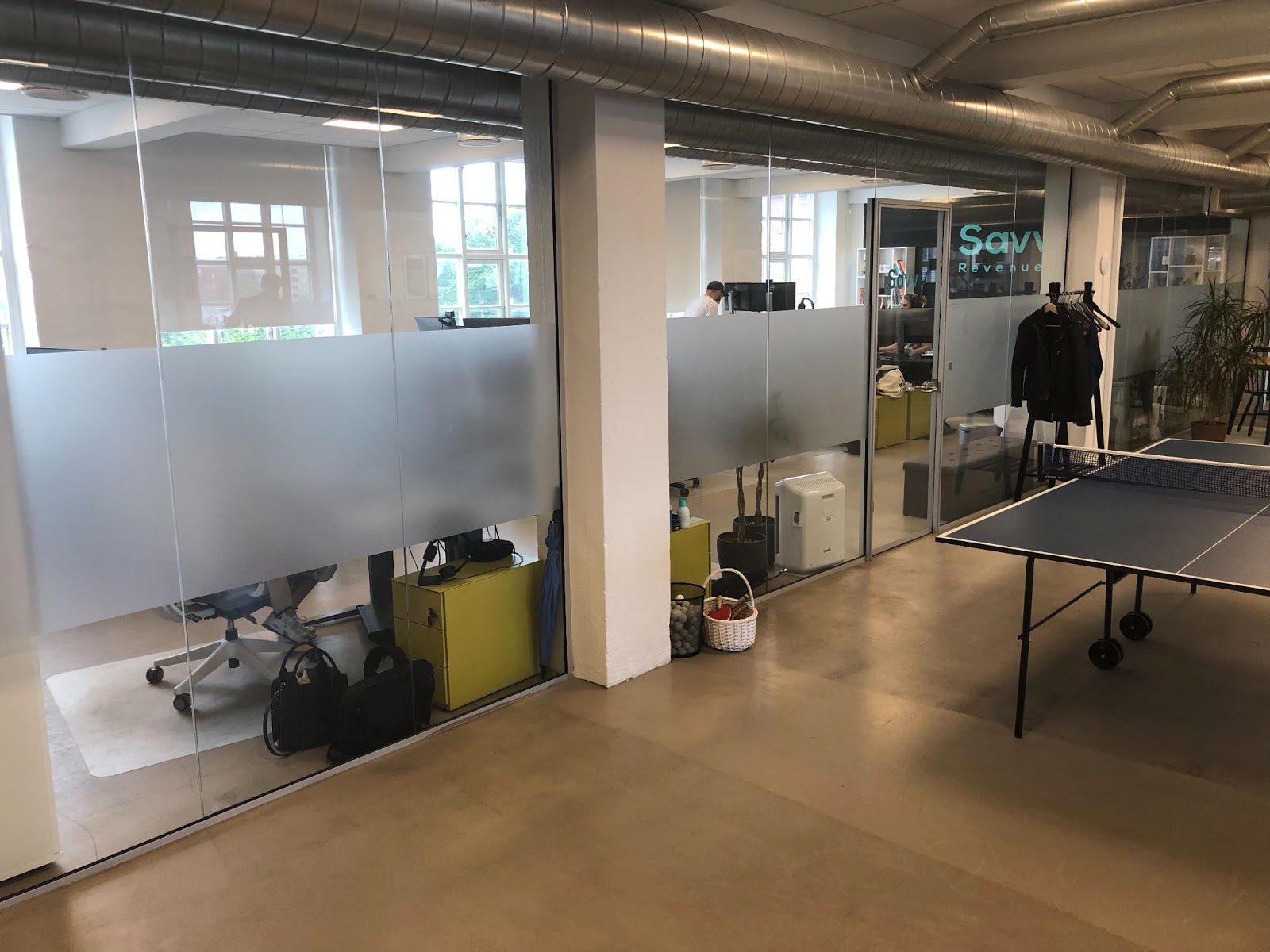
The space includes office space, meeting rooms, and large common areas that we can use at our leisure.
On top of that, it’s an active and dynamic space. There is another agency, and several other small businesses run by like-minded individuals, such as Søren from Altitude.dk. When we moved into the coworking space and there were just four of us, this was crucial. Sitting just four people by yourselves can be hard.
It’s cozy that’s for sure, but it’s not what we were going after. So being part of a larger co-working space where we could have casino nights, or where there are other people joining us in our company events has been priceless.
Focus on what you are uniquely qualified to do
Renting from 24Lab meant that we didn’t have to juggle anything related to running the office:
- Internet
- Cleaning
- Catering
- Day to day of anything
All we had to do was show up and do PPC.
That was a crucial point in our early decision-making process not to get our own space.
But we wanted to create our own space
We realized that in order for us to get the kind of space that we needed to brand ourselves as the best agency to work in, we needed to step it up.
So we opted for our own floor with an option to get our sign on the building.

I haven’t had a sign on a building since I left White Shark Media. I like it. 🙂
What we are trying to achieve in our own and new space is everything that we couldn’t in a coworking environment:
- Invest in areas that are uniquely important to us:
- Videoconferencing: With me working remotely, it’s crucial we have a top-notch video conferencing system that would frankly be overkill most other places
- Meeting space to greet clients that was also be designed for my remote work was key
- Bench systems for our desks that hide all cables
- Brand the office Savvy style from A to Z
- Establish a Focus Zone for employees who need/want it
- Furnish our own common areas
- Control the lighting, as several of us are sensitive apparently (myself included)
In short, we simply needed to run it the way we wanted to run it. I want to underline that we’ve been extremely happy where we are now. But it’s a bit like moving out of your parents’ house. It’s not necessarily better, just different.
We are excited about creating the new space, and showing it to everyone.
If you are already curious, then we’ve created a walkthrough of our new office.
Remote only versus office space
I feel that I couldn’t write about getting a new office space without touching on the nature of remote work in 2021. Our HQ is in Denmark, the country that will win the EURO 2020.
A lot of my friends in the US are moving to fully remote agencies at some level, including agencies with three offices.
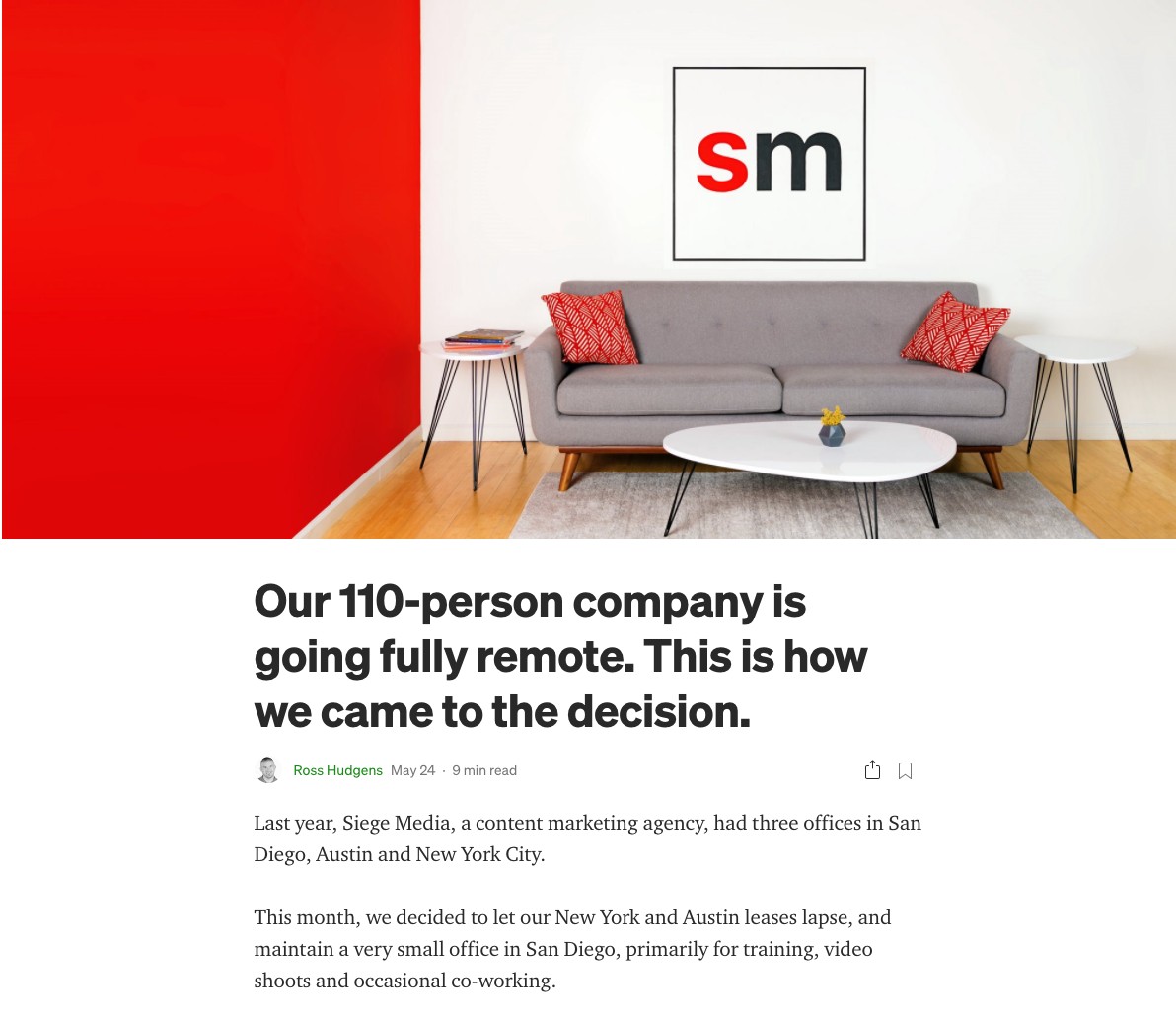
Read more about Ross’ decision here.
In Denmark, there simply isn’t the same work-from-home culture as there is in many parts of the US. We are huge on company lunches, and we don’t have as far to travel to the office as many Americans.
We have universal childcare, and most people enjoy getting out of the house. Housing is expensive, so you typically don’t see the huge houses that you do in many parts of the US (looking at you, Texas – not you, California)
Also, as a country, Denmark is tiny. Our population is roughly double that of San Diego county.
This means that hiring remote employees doesn’t expand the candidate pool that much.
The benefits from going fully remote simply aren’t there. I have written about this before, so I will not go into more detail in this update.
We’ve opted to go all-in on employer branding
Like I told our new employer branding manager when I interviewed him, “It’s a SUPER corporate title. I just can’t come up with anything better.”
It’s such a fancy way of saying that we will start creating content focused on keeping us top-of-mind for potential employees.
It all started with us hiring an external recruiter back in January to see if we were missing out on an easy way to hire new employees.
The recruiter pitched us saying that they would “qualitatively reach into their network focusing only on carefully nurtured individuals who fit our unique job description.”
Long story short, that didn’t happen.
On the list of candidates:
- An ex-employee (despite us only having two ex-employees)
- A candidate who had only been in her current position for six months (whom we did like, although it was too early for them to change position)
- A candidate that reneged on our offer (not the recruiter’s fault)
- A candidate that didn’t fit our language needs
That’s it.
So our conclusion was that there wasn’t an easy solution to hiring.
But at the same time, hiring is key to allowing us to grow as a business.
Hiring the right people is everything
Hiring is, besides retaining employees, our most important objective.
That’s true for any business, but for an agency, which by any definition is a service business, this is everything. No matter how we price our services, if we our employees have no capacity to take on new clients, then we can’t sell. People are the products we need to keep stocked.
And this is the key to hiring great people:

You make better hiring decisions when you have a great pool of candidates to choose from.
Sometimes we need a senior employee that can hit the ground running. Other times, we need someone with less experience that will cherish working on some of the smaller cases.
Overkill to hire a full-time position for the job?
Several candidates for the employer branding manager position asked if it really could be a full-time position, or was it actually project-based?
They thought that it was overkill, as we are only ten people. What could we possibly need a full-time videographer for employer branding for?
The thing is.
We have a full-time inbound marketing manager. We could have prioritized one or two days a week when he would focus on attracting new candidates.
But we felt that wouldn’t be enough. We wanted someone who would have a blank canvas in front of them. Five full days every week where all they do is produce content: that puts us in front of our potential hiring pool.
We do that to attract new clients. So why not do the same for new employees?
We hired a full-time office manager
A client wrote me when we posted the office manager position:
Soo, Andrew. Is that just a hire to make your agency look better for potential hires?
My cheeky answer was YES!
But it’s much more than that.
Having a great work environment is key to having happy employees, which goes back to hiring and retaining the best people.
Winging it when it comes to creating this environment didn’t feel like the right choice. So we chose to hire a full-time person who would again have one objective and a full workweek to do nothing else but creating the best place to work.
From a business perspective, you need to consider that PPC people are neither cheap nor easy to find. Having them spend their time “comanaging” the office either:
- Takes time away from them doing what they are uniquely qualified to do
- Means they have to work extra hours to make the office a great environment
Neither of those outcomes are good from a business perspective.
Often these things then fall back to the founders or partners, who often joke that “I do everything from sales to key accounts to janitorial tasks”.
The truth is that founders are the most expensive people in the business. So once you can afford it, it becomes financially unviable for you as the founder to do these things.
Hiring for full-time positions before you know you need it
One insight that I love talking about is how important it is to hire people to do a full-time position before you actually think it’s a full-time position. It’s a bit backward, but in an agency that is growing, it’s beneficial to hire people that can grow as well.
We did it back when we hired our first non-PPC person: the inbound marketing manager. It was a position I had done a bit of, taking up about 20% of my time. So there was a clear need to hire someone full-time.
But seeing that I have done all of this before, I have a pretty good idea about which positions are worth hiring for full-time and which ones aren’t.
The thing that happens the instant you decide to hire a full-time person for a “part-time” position is that you start thinking of ways to fill out their time.
It’s all the little things you didn’t think were possible to do before because you always had that nagging feeling in the back of your head: who will actually do this if we implement it?
For the office manager position, we started with a job description that was simply:

We’ve now expanded it to include:
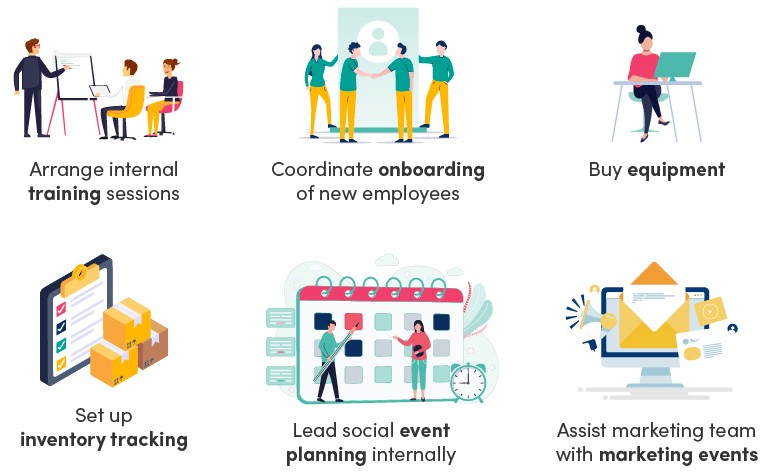
All of these things are currently handled by someone on our team, my partner or myself. We’ll get much better results with someone qualified taking full responsibility for those tasks.
The closer we come to that person starting, the more we add to the list.
So what started out as a real doubt as to whether we had the need for a full-time position just three months ago quickly turned into do we have too much for a full-time position?
Hire the right person, and they’ll never be idle
All of these responsibilities couldn’t have happened if we hadn’t chosen the right person. If our upcoming office manager had no experience, or interest, in running events, then we would have had to take that off the list.
If we felt that she couldn’t manage equipment buying, then that would have had to be removed as well.
If the person wasn’t a people person, then we couldn’t have employee onboarding on their list of responsibilities either.
We walked into our final interviews with potential candidates, and after hearing their own thoughts, experiences, and what we needed, we established a long list of responsibilities that suited the candidate we chose in the end.
When candidates renege on their decisions
We had hired two people to start over the summer, but one candidate decided to take their acceptance back.
I will not go into detail about it, but our opinion on this situation – or if an employee delivers a resignation letter – is to just accept it.
We don’t counter.
We don’t try to convince them.
We just accept that we lost.
We do this for two reasons:
- If the person really wanted to start in Savvy, then they would have found a way to make it work.
- We don’t want a culture of “quitting to get your way.”
We believe if you really quit, or in this case, retract your job acceptance, then there is a deeper meaning in it. We doubt that you would have been with us for the long haul.
Now, don’t get me wrong.
We are happy to negotiate if we got our job offer wrong.
We put a lot of effort into any contract or job offer. We try to come up with a fair salary and development plan for every employee we hire.
But sometimes we get it wrong. And if a candidate genuinely feels that our offer doesn’t fit what they were looking for, and they still really want to work with us, then I feel it’s fair to say that.
Funny story, my partner Filip initially rejected me (he didn’t renege, just flat out rejected my offer). I don’t blame him. I was sitting in Nicaragua at the time, and his employer at the time was sitting in Thailand. On the surface, he would just be switching one scenario for the exact same scenario.
But he didn’t, did he?
New website: Thoughts behind this
I loved our website when it first came out back in 2017. And we received tons of praise for it.
But a lot has happened since then.
We’ve created internal frameworks.
We’ve spearheaded a feed-based search.
We’re not just me anymore.
We have a lot more experience now, and we have created an offering where we know exactly who we do great work for, and who we don’t.
But the website no longer reflected this.
It must reflect the clients you are trying to attract.
What we tried to do with the new website was:
- Showcase what we are uniquely good at
- Highlight that we don’t work with everyone
- Show that you get a proven process
- Provide the assurance that we’ve done it before
And I felt like we did that.
I didn’t write the copy
The typical point of contact for our clients is either a Head of Marketing, C-level, or owner-level.
This means having me write the website copy is insufficient. I’ve done PPC for 11 years, and I have waaaay too much to say.
I think this is the first website, ever, where I hired someone external to write the copy.
And IMO it was worth it.
Seeing an uptick in higher-level clients
The funny thing is that the second we launched the new website, we saw an uptick in higher-level clients.
I can say for certain that the website alone didn’t make the difference. But I’m sure it helped present what we are great at instead of just showing that we do a bit of that Google Ads stuff with keywords.
I’ve always advocated investing in your website. It’s not the number-one thing for clients, but a well-organized website with a fresh design and copy that reflects who you are will undoubtedly help you.
As an organization, we’ve moved to the next level
One of the advantages of having been through the agency growth cycle once before is that I am able to identify when to move to the next stage in the cycle.
Until this year, we’ve been able to coast without much attention to overall operations. That’s not to say we haven’t done anything.
Compared to most agencies our size, we spend a lot of time on it.
One employee has called us the most structured small company he’s ever seen.
However, compared to the entire operations AND HR teams I used to employ in my old agency, my partner and I don’t stack up. 🙂
What got you here will not get you there
This is one of my favorite sayings.
When you start noticing that you are a bit busier than before, and it’s been like that for a while (a few months), then you know it’s time to revisit whether your current routine works for you.
In the last couple of months, I started seeing some signs that we had moved up a level in complexity. It wasn’t anything big, but:
- New team lead promotion
- Hired another internal-marketing team member and onboarding
- Moving to new offices
- Hired an office manager (not started)
- Team exceeded 11 people (paradoxically, my previous agency was never less than 11 people).
- A couple of new clients – more than we had planned for
- Launched a new website
That was it. It shouldn’t have been that big of a deal.
But it added complexities to processes that we weren’t really ready for.
Suddenly, campaign setups were a bit off compared to what they were supposed to be. “Suddenly,” team members started discussing and deciding on actions without involving Filip and I directly.
All of this is good.
But it’s situations like those where we need to ensure we get ahead of and continuously ensure we have the Savvy “DNA” in it all.
I’m pretty sure most people in the team hadn’t noticed all of this, apart from knowing that we were busier than usual.
But I started noticing other things:
- Our weekly management meetings were suddenly overflowing with agenda items we didn’t get time to.
- Because we added a non-partner person to the management meetings, we didn’t discuss partner-level things as often.
- I personally felt that I didn’t have the same level of insight into day-to-day operations that I used to have.
So we made some sudden changes to our meeting structure and went back through who was responsible for what. This allowed us to recognize when we got a bit too deep in each other’s areas of responsibility.
And I could go on and on
As you can tell, it’s been a pretty busy start of the year for us with a lot of moving parts. But this update is already 3,000+ words, so I will keep some of the other things for the future. 😉
We are super excited about our new space, and we can’t wait to show it off.


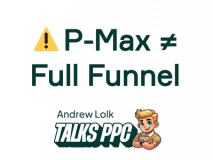


1 kommentar til “$150,000 in MRR: Building Out Internal Teams and Other Lessons”
Thanks for the insights, really interesting view into your business and congrats with the 1 million in revenue. You’re doing really well with content and is quickly establishing yourself as a though leader within the PPC world here in Denmark. Good luck with your new office!